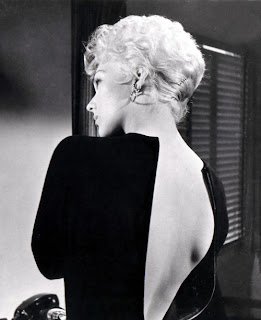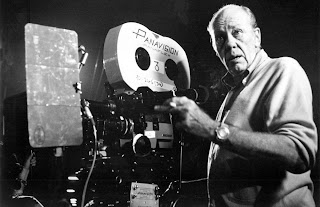 Kim Novak was recruited by Columbia's legendary Harry Cohn to rival Fox's Marilyn Monroe in what was the Battle of the Blonde Bombshells in the 1950s. This standoff was so deliriously deranged Fox even came up with two of its own rivals for Monroe - Jayne Mansfield and Sheree North.
Kim Novak was recruited by Columbia's legendary Harry Cohn to rival Fox's Marilyn Monroe in what was the Battle of the Blonde Bombshells in the 1950s. This standoff was so deliriously deranged Fox even came up with two of its own rivals for Monroe - Jayne Mansfield and Sheree North.The men were pigs - Fox created, exploited and then systematically destroyed Marilyn - but the women, to their credit, were all different, not cookie-cutter replicas of each other: Monroe was vulnerable but shrewd and, in a passive-aggressive way, self-protecting; Mansfield had a brain and a solid Broadway background, and North was a savvy woman and world-class actress who could also sing and dance. And Kim, well, she was totally unexpected - not a "dumb blonde" at all but a haunted, quietly sensual woman with a look of deep hurt in her eyes.
Novak competition for Monroe? Now really, could you see Novak in any of Monroe's roles? "Gentleman Prefer Blondes"? "Some Like It Hot"? I don't think so. "The Misfits" maybe, but that's it.
Having lived most of her career in the shadow of Monroe, Novak can be seen now as something of a slow starter, given that her career is only starting to be appreciated. The estimable Jonathan Rosenbaum offers some vivid commentary on her that's worth checking out.

Anyway, I think that it's safe to say that Novak not only has a much more impressive filmmography than Monroe, but also that she worked with a more eclectic and fascinating collection of moviemakers.
This is evident in the titles that Turner Classics has strung together for Kim Novak Day scheduled for Tuesday, August 12th. Here's the line-up (with all times est), annotated only when I have something to say:

6:00 AM - "The Eddy Duchin Story" (George Sidney, 1956,123 minutes) Letterbox Format. Novak,although briefly on screen, is the invaluable glue of this powerful tale of a father and son trying to bond, belatedly. It's more than just a musical biopic.
8:30 AM - "Jeanne Eagels" (Sidney, 1957, 109 minutes) Worthy of serious re-evaluation.
10:30 AM - "Phffft!" (Mark Robson, 1954, 88 minutes) The riotous Rhumba sequence with Jack Lemmon and Judy Holliday is a keeper, along with Jack Carson's inspired speech of facial hair in attracting/repelling women. Kim, free of her "Pushover" babyfat and looking more like herself, has a comic highlight here when she switches on the beaming lights in a window statue that is used to alert potential intruders that it's an, ahem, inopportune time to enter.

12:00 PM - "Kiss Me, Stupid" (Billy Wilder, 1965, 125 minutes) Letterbox Format.
2:00 PM - "The Notorious Landlady" (Richard Quine, 1962, 123 minutes) Letterbox Format. Lemmon signed on for this when it was titled "The Notorious Tenant" (based on a Margery Sharp short story of the same title) and he was the title star. Columbia newcomer Victoria Shaw was slated to play his fetching landlady until Kim showed an interest in the project. Quine, close with both Kim and Jack, as a natural fit as the director. The title was changed to accomodate Kim, its new star.
4:15 PM - "Of Human Bondage" (Ken Hughes, 1964, 100 minutes) Letterbox Format.
6:00 PM - "Middle of the Night" (Delbert Mann, 1959, 117 minutes) Letterbox Format. Kim demonstrates surprising chemistry opposite Fredric March in this most affecting May-December love story from Paddy Chayefsky.
8:00 PM - "Pushover" (Quine, 1954, 88 minutes) Letterbox Format. Kim's First, directed by Quine.
9:45 PM - "Five Against the House" (Phil Karlson, 1955, 83 minutes) A nifty little caper/noir. Kim's third film and her transformation to "star" is complete.

11:15 PM - "Vertigo" (Alfred Hitchcock, 1958, 130 minutes) Letterbox Format. You know the drill.
1:30 AM - "The Legend Of Lylah Clare" (Robert Aldrich, 1968, 130 minutes) Letterbox Format. Aldrich's neglected camp classic. Both it and Kim are very good, compulsively watchable.
4:00 AM - "Strangers When We Meet" (Quine, 1960, 117 mins) Letterbox Format. It's been called Quine's masterwork recently and it is.
Kim makes her sex-starved suburban housewife's ache almost palpable.

Three key titles that are missing are Joshua Logan's "Picnic" (1955), of course, Otto Preminger's
"The Man with the Golden Arm" (also '55), Sidney's "Pal Joey" (1957) and Quine's "Bell, Book and Candle" (1958), which, for me, provided Novak with her signature role -a contemporary witch in '50s Greenwich Village. For what it's worth, Novak did her very best work for Quine, making four films with him.
She was his muse and he was her lover.
Coincidentally, Quine has been in the spotlight of late, with his name and some of his titles popping up regularly among the discourse on Dave Kehr's blog and with the ongoing "Richard Quine at Columbia" retrospective at the Los Angeles County Museum of Art.
LAWeekly.com offers two wonderful pieces on Quine - one a late-in-life interview with the director by Philippe Garnier and an asssessement of the Museum's program by Scott Foundas.
(Artwork: Novak gets made over, but not as Monroe, in Hitchcock's "Vertigo," in "Strangers When We Meet," with Lemmon in "The Notorious Landlady," with Fredric March in "Middle of the Night," with Kirk Douglas in "Strangers When We Meet" again, and director Richard Quine on the job)








